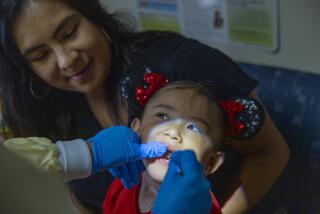MEDICINE : Bad Breath Has Smell of Success for Some
- Share via
For some dental professionals, it’s little more than a marketing ploy. For a specialist in Philadelphia, it’s a rip-off of his earlier work. But for 75-year-old Frances Brower, it was an answer to her prayer to be rescued from the bad breath that has haunted her since early adolescence.
“Recently I said to the Lord, ‘Dear God, this has been going on since I was 11 years old,” said Brower, who was moved to prayer by a 6-year-old granddaughter’s complaint about Grandma’s halitosis.
“ ‘Dear God,’ ” she recalls saying, “ ‘can’t we reason together? If you grant me this, I won’t ask for anything else.’ ”
Shortly afterward, Brower saw an ad for the California Breath Center, a Pico Boulevard dental office that claims to be the only clinic on the West Coast that specializes in the treatment of clinically bad breath.
Three weeks later, she went back and registered a low reading on the clinic’s Halimeter, a device that measures the presence of hydrogen sulfide and methyl mercaptan, the “rotten egg” gases that are often responsible for halitosis.
Other causes can be sinus infections, lung problems or stomach infirmities, but in most cases, specialists say, bad breath can be traced to the presence of anaerobic bacteria--microorganisms that flourish in an oxygen-poor environment.
Some people have more of the microbes than others, said Dr. Harold Katz, who runs the California Breath Center with his brother, Richard, also a dentist, and their friend, Jerry Jacobs, a medical doctor.
Reasons for the condition can vary, but people with chronically dry mouths often have bad breath because the lack of oxygen-rich saliva makes for a friendly environment for anaerobic microbes, Katz said. As people age, they produce less saliva and the problem gets worse.
In chronic cases, mouthwash alone only masks the problem. The $450 treatment includes an exam, medical history, teeth-cleaning and tongue-scraping, followed by a home regimen of brushing and rinsing with a medicated toothpaste and mouthwash.
“I was so pleased, and so was the doctor,” said Brower, a retired legal secretary and former Santa Monica resident who said she was ashamed of her halitosis despite her late husband’s tolerance for the condition.
She recently moved to Riverside, and she hasn’t heard any more complaints from her granddaughter.
In fact, Brower said, she now calls the girl “better than a best friend,” because bad breath is something even your closest pal would hesitate to mention. And the sufferers themselves find it hard to discuss.
“People will talk about their sex life, they’ll talk about how much money they make, but this is one of the types of problems people don’t want to talk about,” Katz said.
Relying on advertising, referrals from other dentists and word of mouth, the clinic has treated hundreds of patients since opening in May, Katz said. Plans are under way to open offices in San Francisco, Newport Beach and San Diego.
“Thank God, we’ve been very successful,” he said.
Katz and his partners are not alone; treatment of chronic bad breath is a growing segment of the dental care industry nationwide.
Manny Shaw, who manufactures Halimeters at his Intrascan plant in Chatsworth, said he has sold hundreds of the devices this year, double his sales over the previous five years.
But it is not clear that halitosis specialists are providing much more than would be available from a regular dentist, according to academic sources.
“Certain of the services that are provided would be what we would call maintenance--dental prophylaxis and periodontal treatment--all of which can have an effect on the breath of the individual . . . (and) which is available through all general and periodontal offices,” said Jack Conley, associate professor of Dental Medicine and Public Health at USC.
“I don’t know how legitimate or profiteering it is. It could be very appropriate and very good or a real scam,” said Glenn Clark, associate dean of research at the School of Dentistry at UCLA. “What I do know is that the whole area of malodor is of interest to the dental community. It’s an area that looks promising.”
Although earlier work was done in Israel and Canada, the first American dentist to offer specialized care for bad breath was Philadelphia periodontist Jon L. Richter.
“Most of the research has been done by scientists who were really interested in what they might find in breath gases that might be useful for diagnosis of medical problems. It was sort of accidental that they encountered large amounts of volatile sulfur compounds,” he said.
“The run-of-the-mill dentist has access to this information. Whether he has the training and experience in treating bad breath is another matter. The run-of-the-mill dentist has access to scalpels but they don’t do brain surgery.”
Relations are not warm between Richter and the California Breath Center, part of whose printed list of frequently-asked questions is echoed word-for-word from a brochure he distributes. One of the few differences is in the estimates of the size of the problem, with Richter speculating that there are 25 million chronic sufferers nationwide while the Katzes and Jacobs say there are 80 million.
“That group has actually taken all our literature and basically reproduced it and is spreading it out on their own,” Richter said. “I’ve got a lawyer working on it.”
In response, Jacobs acknowledged that he saw Richter’s brochure before drawing up his own. “I’m not a professional writer,” he said. “I’m a physician.”
In any case, he said, “There’s no question that he was the first in the country to have a halitosis center. That doesn’t mean anybody else is not allowed to open another. The brochure is just a small part of our marketing.”






